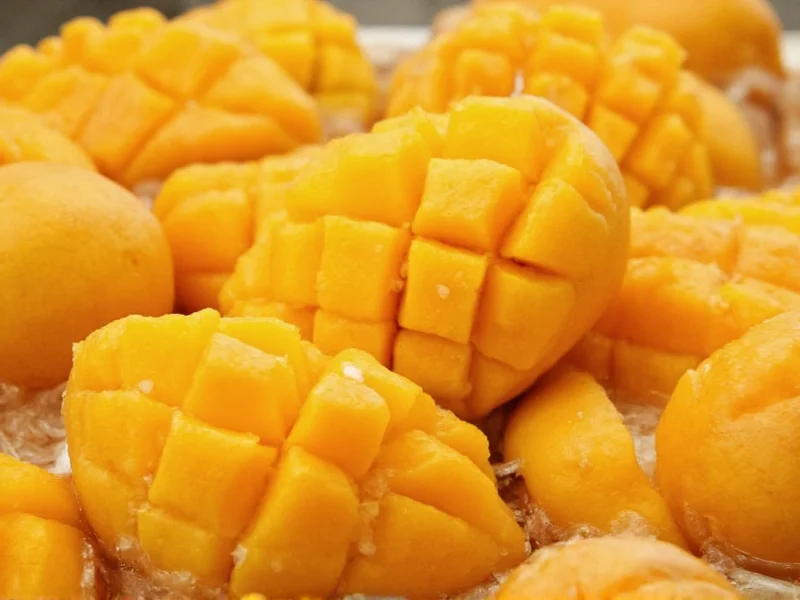A mangonada represents one of Mexico's most beloved street beverages, blending tropical fruit with savory and spicy elements in a way that perfectly captures the country's complex flavor profile. Unlike simple mango smoothies, this distinctive drink features a carefully balanced combination of sweet, sour, salty, and spicy components that create a multi-dimensional taste experience.
Key Components of an Authentic Mangonada
The magic of a mangonada lies in its specific ingredients working in harmony. Traditional recipes include:
- Ripe mango purée - Typically made from Ataulfo or Kent mango varieties
- Chamoy sauce - A pickled fruit sauce made from apricots, plums, or mangos with chilies
- Lime juice - Adds necessary acidity to balance the sweetness
- Chili powder - Usually Tajín or similar chili-lime seasoning
- Ice - Blended to create a slushy consistency
- Salt or chili-salt rim - For the glass
- Tamarind candy straw - Served as both garnish and edible utensil
| Drink Type | Primary Ingredients | Texture | Flavor Profile | Origin |
|---|---|---|---|---|
| Mangonada | Mango, chamoy, chili, lime | Slushy | Sweet-tangy-spicy | Mexico |
| Mango Smoothie | Mango, yogurt/milk | Creamy | Sweet | Global |
| Mangoneada | Mango, chamoy, tamarind | Slushy | Sweet-sour-spicy | Mexico |
| Mango Lassi | Mango, yogurt, milk | Smooth | Sweet-creamy | India |
Origin and Cultural Significance
The mangonada emerged from Mexican street food culture, where vendors creatively combined available ingredients to create refreshing beverages for hot climates. While precise origins are difficult to trace, food historians believe mangonadas developed in western Mexico during the late 20th century as chamoy sauce became more widely available.
What distinguishes mangonadas from similar drinks is their unique flavor progression. When properly prepared, you first taste the sweet mango, followed by the tangy lime and chamoy, finishing with a subtle chili warmth. This layered experience makes mangonadas particularly appealing as they engage multiple taste receptors simultaneously.
Mangonada vs. Mangoneada: Understanding the Difference
Many people confuse mangonadas with mangoneadas, but there are subtle yet important distinctions between these two popular Mexican beverages. While both feature mango and chamoy, a traditional mangoneada includes tamarind paste as a key ingredient, giving it a more pronounced sour note. The name "mangoneada" literally combines "mango" with "tamarind" ("membrillo" in Spanish, though often shortened in colloquial use).
In practice, many vendors use the terms interchangeably, particularly outside Mexico. However, authentic preparation maintains this distinction, with mangoneadas offering a more complex sweet-sour profile while mangonadas emphasize the mango-chamoy combination.
Regional Variations Across Mexico
As mangonadas spread throughout Mexico, regional variations emerged:
- Western Mexico - Considered the birthplace, featuring the classic recipe with emphasis on high-quality mango
- Mexico City - Often includes additional fruit flavors like strawberry or tamarind swirls
- Northern Mexico - Tends to be spicier with extra chili powder and less sweetness
- Coastal regions - May incorporate local fruits like guava or pineapple for variation
These regional differences reflect Mexico's diverse culinary landscape while maintaining the essential mangonada identity.
How to Experience an Authentic Mangonada
For the most authentic mangonada experience, seek out Mexican street vendors or specialized fresas (fruit stands) that prepare them fresh. Look for establishments that make their chamoy in-house rather than using commercial brands, as this significantly impacts flavor quality.
When ordering, you'll typically have options for:
- Spice level (mild to extra spicy)
- Mango ripeness (less ripe for tartness, riper for sweetness)
- Additional flavors (strawberry, tamarind, or chamoy swirls)
- Texture preference (thicker or more liquid)
The presentation matters too - authentic mangonadas feature the distinctive salt-chili rim and tamarind candy straw, which gradually dissolves into the drink, adding complexity as you consume it.
Creating Mangonadas at Home
While street-vendor mangonadas offer the most authentic experience, you can create satisfying versions at home with these basic steps:
- Prepare mango purée from ripe Ataulfo mangoes
- Mix with quality chamoy sauce (look for brands with natural ingredients)
- Add fresh lime juice to balance sweetness
- Blend with ice until slushy consistency
- Rim glass with chili-salt mixture
- Pour mixture into glass
- Add tamarind candy straw
For best results, use ripe but firm mangoes and high-quality chamoy without artificial colors or flavors. The ratio of mango to chamoy typically ranges from 3:1 to 4:1 depending on desired tartness.
Why Mangonadas Continue to Gain Global Popularity
Mangonadas have expanded beyond Mexican communities to become a global phenomenon for several compelling reasons. Their complex flavor profile appeals to evolving palates that appreciate sweet-spicy combinations. The vibrant orange color makes them visually appealing for social media. Additionally, as interest in authentic ethnic street foods grows, mangonadas offer an accessible entry point to Mexican culinary culture.
Food historians note that mangonadas represent a perfect example of antojitos (Mexican snacks) that successfully transitioned from street food to mainstream popularity while maintaining their cultural authenticity. Unlike many fusion foods that lose their original character, mangonadas have retained their essential identity even as they gain international recognition.











 浙公网安备
33010002000092号
浙公网安备
33010002000092号 浙B2-20120091-4
浙B2-20120091-4